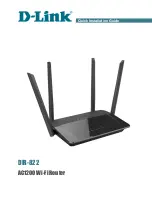
IPsec VPN Settings
Name
This field is for specifying a local name to represent this connection profile.
Active
When this box is checked, this IPsec VPN connection profile will be enabled. Otherwise, it
will be disabled.
Connect Upon
Disconnection
of
Check this box and select a WAN to connect to this VPN automatically when the specified
WAN is disconnected.
Remote
Gateway IP
Address /
Host Name
Enter the remote peer’s public IP address. For
Aggressive Mode
, this is optional.
Local
Networks
Enter the local LAN subnets here. If you have defined static routes, they will be shown
here.
Using NAT, you can map a specific local network / IP address to another, and the packets
received by remote gateway will appear to be coming from the mapped network / IP
address. This allow you to establish IPsec connection to a remote site that has one or
more subnets overlapped with local site.
Two types of NAT policies can be defined:
One-to-One NAT policy: if the defined subnet in Local Network and NAT Network has the
same size, for example, policy "192.168.50.0/24 > 172.16.1.0/24" will translate the local
IP address 192.168.50.10 to 172.16.1.10 and 192.168.50.20 to 172.16.1.20. This is a
bidirectional mapping which means clients in remote site can initiate connection to the
local clients using the mapped address too.
Many-to-One NAT policy: if the defined NAT Network on the right hand side is an IP
address (or having a network prefix /32), for example, policy "192.168.1.0/24 >
172.168.50.1/32" will translate all clients in 192.168.1.0/24 network to 172.168.50.1. This
is a unidirectional mapping which means clients in remote site will not be able to initiate
connection to the local clients.
Remote
Networks
Enter the LAN and subnets that are located at the remote site here.
Authenticatio
n
To access your VPN, clients will need to authenticate by your choice of methods. Choose
between the
Preshared Key
and
X.509 Certificate
methods of authentication.
Mode
Choose
Main Mode
if both IPsec peers use static IP addresses. Choose
Aggressive
Mode
if one of the IPsec peers uses dynamic IP addresses.
Force UDP
Encapsulation
For forced UDP encapsulation regardless of NAT-traversal, tick this checkbox.
http://www.peplink.com
103
Copyright @ 2017 Pepwave
Summary of Contents for BR1 ENT
Page 91: ...http www peplink com 91 Copyright 2017 Pepwave ...
Page 102: ...http www peplink com 102 Copyright 2017 Pepwave ...
Page 174: ...http www peplink com 174 Copyright 2017 Pepwave ...
Page 182: ...http www peplink com 182 Copyright 2017 Pepwave ...
Page 197: ...All WAN Monthly Bandwidth Usage http www peplink com 197 Copyright 2017 Pepwave ...
















































